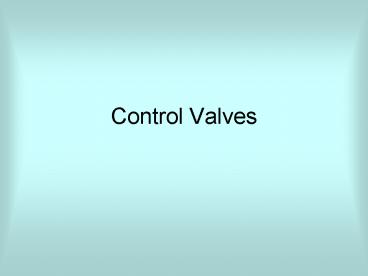Control Valves - PowerPoint PPT Presentation
1 / 32
Title:
Control Valves
Description:
DC Solenoid. Same current throughout stroke. Constant closing time. Quiet operation ... AC Solenoid ... Pilot Operated Solenoids. 32. Trio. Filter. Pressure ... – PowerPoint PPT presentation
Number of Views:12369
Avg rating:5.0/5.0
Title: Control Valves
1
Control Valves
2
Types of Valves
- Directional Control Valves
- Sliding Spool Valves
- Poppet-Type Valves
- Flow Control Valves
- Pressure Control Valves
- Manual Shut-off Valves
3
Spool Principle
4
Spool Principle
5
Spool Valves
- System pressure does not cause spool to move.
- If more streams are needed, spool is made with
more than one groove.
6
Spool Valve
7
Action of the 2 -way
8
3-Way Normally Closed
9
3-Way Normally Open
10
Common Valve Actions
11
Poppet Valves
Poppet valves are always unbalanced. Not suited
to high pressure at high flowrate.
12
Poppet Valves
Air Pilot Operated
Solenoid Operated
Foot Pedal Poppet
13
DC Solenoid
Same current throughout stroke Constant closing
time Quiet operation 6,12,24 Volts are standard
14
AC Solenoid
Takes more current when plunger is out of the
coil and can therefore burn up if it sticks. Must
close completely to reduce current to safe
level. Faster than DC but closing time is
variable. Can be noisy (hum) 110, 230 VAC are
standard
15
(No Transcript)
16
(No Transcript)
17
AC Coil Current Heating
- If the armature does not close far enough, the
reactance of the coil will remain low. - The low reactance will permit too much current in
the coil. - The coil will heat and burn out prematurely.
18
Pressure Relief Valves
Equalizes pressure
19
Piloted Pressure Relief Valve
If system pressure goes high, needle valve opens
relieving pressure on top of poppet.
20
Application of Pressure Relief Valve
Coasting
Driven
21
Gate Shut-Off Valves
22
Ball Valve
23
Needle Valve
24
Flow Control Application
Needle Valve
DP only if there is some resistance to piston.
25
Four and Five-Way
26
(No Transcript)
27
(No Transcript)
28
Four Way Air Valve
Dual Exhausts
29
Direct acting solenoids
30
Solenoid Operated Valves
31
Pilot Operated Solenoids
32
Trio
Filter Pressure Regulator Lubricator































